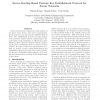901 search results - page 43 / 181 » Minimum power configuration in wireless sensor networks |
COMCOM
2006
13 years 8 months ago
2006
Wireless sensor networks constitute the platform of a broad range of applications related to national security, surveillance, military, health care, and environmental monitoring. ...
COMCOM
2008
13 years 8 months ago
2008
Convergecast is a fundamental operation in wireless sensor networks. Existing convergecast solutions have focused on reducing latency and energy consumption. However, a good desig...
IPCCC
2005
IEEE
14 years 2 months ago
2005
IEEE
Sensor networks are composed of a large number of low power sensor devices. For secure communication among sensors, secret keys must be established between them. The establishment...
AINA
2009
IEEE
14 years 3 months ago
2009
IEEE
— Wireless sensor network consisting of a large number of sensors is effective for gathering data in a variety of environments. Since the sensors operate on battery of limited po...
ATAL
2005
Springer
14 years 2 months ago
2005
Springer
Interpolation is a technique used to estimate the value of a function at a given location, assuming that the values of the function are known for surrounding locations. A Wireless...

